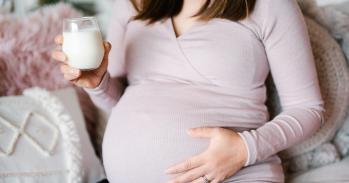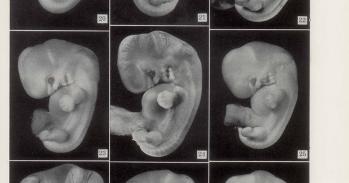
Most pregnancies develop normally but when complications arise they can have devastating effects. Two recent initiatives in Cambridge hope to deliver a new understanding of events during this critical period of human life.
Most pregnancies develop normally but when complications arise they can have devastating effects. Two recent initiatives in Cambridge hope to deliver a new understanding of events during this critical period of human life.
Thanks to an industrial collaboration with GE Healthcare, the long-term loan of two state-of-the-art scanners will enable real-time three-dimensional scanning of the babies in utero.
Complications in pregnancy represent a persistent and major problem in public health. The first three months after conception are known to be the most critical, with as many as 20% of pregnancies lost during this time. For pregnancies that develop beyond 24 weeks, between 0.5 and 1% result in death of the baby, either in the womb or in the first four weeks of life. Premature birth can incur major complications associated with delivery, immediate care of the infant, childhood diseases, and educational and social problems in later life. Not only is there an emotional cost to families, but an economic assessment in the USA reported that the cumulative subsequent healthcare and social costs associated with one year’s worth of pre-term deliveries was $26 billion. Understanding and intervening to prevent these events is clearly crucial.
Although some advances have been made, the dismaying fact is that the rates of stillbirth have generally remained static over the past 20–30 years. This partly reflects an incomplete understanding of the biological events that lead to these complications of pregnancy. Determining what these mechanisms might be is essential for devising new strategies of intervention, and applying in-depth scientific studies to human pregnancy is now seen as vital.
Two multidisciplinary initiatives in Cambridge have recently embarked on improving our understanding of pregnancy and its outcomes: a large antenatal screening of women at the Rosie Maternity Hospital in Cambridge and the recent endowment of a Centre for Trophoblast Research within the School of Biological Sciences. Both initiatives build on the wealth of expertise in the biology of pregnancy that exists across Cambridge.
Screening for adverse outcomes
A four-year research project that aims to monitor 5000 pregnant women commenced in 2007 under the leadership of Professor Gordon Smith in the University’s Department of Obstetrics and Gynaecology. A multidisciplinary team of translational researchers in both the School of Clinical Medicine and the School of Biological Sciences are participating in the project, which is funded under the Women’s Health theme of the UK Department of Health’s Cambridge Comprehensive Biomedical Research Centre.
Women enrolling in the study are scanned and give blood samples at 12, 20, 28 and 36 weeks of gestation, allowing detailed characterisation of the baby’s growth and development. Thanks to an industrial collaboration with GE Healthcare, the long-term loan of two state-of-the-art scanners will enable real-time three-dimensional scanning of the babies in utero. At birth, samples of placenta and cord blood will be obtained and stored.
The study is prospective; for those women whose pregnancies sadly have complications or adverse outcomes (such as pre-eclampsia, spontaneous pre-term birth, stillbirth or low-birth-weight babies), the stored samples will be retrieved and compared with controls. These samples then become the focus of extensive clinical and biological analyses to try to establish the cause. Studies will analyse the development and function of the placenta and the effect of oxidative stress; the expression or silencing of genes in relation to whether they came from the mother or the father (known as genomic imprinting); the maternal–foetal immune interaction; and the genes that are expressed in the placenta. The MRC Epidemiology Unit will conduct follow-up studies of the growth and development of the babies who have been carefully monitored during the pregnancy.
The hope is that this detailed characterisation of foetal development, on such a large scale, will lead to mechanistic studies on the causes of common clinical problems in pregnancy. As well as providing refined risk assessment, novel treatments might be identified that could improve the outcome of pregnancies in women deemed to be at higher risk.
Centre for Trophoblast Research
The recent endowment of the Centre for Trophoblast Research, due to be launched on 9 July 2008, is a highly innovative initiative aimed at promoting research into trophoblast biology both within Cambridge and on the wider national and international stages. The trophoblast is the cell type that forms the interface between the foetus and its mother, supplying nutrients to support the growth of the foetus. It is fundamental to successful pregnancy and must interact intimately with the maternal cells lining the uterus, leading to the formation of the placenta.
In humans, this interaction is particularly invasive and, during the first few weeks of pregnancy, the foetus becomes completely embedded within the wall of the uterus. This form of placentation, seen only among the great apes, poses unique immunological and haemodynamic challenges. The invading trophoblast cells, which are genetically related to, but distinct from, those of the mother, must negotiate passage with her immune system to allow them to reach their target – the specialised blood vessels in the wall of the uterus. As a result of this invasion, the vessels undergo major structural changes that ensure the placenta has a plentiful and continuous supply of blood in later pregnancy.
There is now abundant evidence that the major complications of pregnancy are associated with deficient trophoblast invasion, resulting in aberrant maternal blood flow to the placenta. Research performed in Cambridge has demonstrated that, paradoxically, too much flow in early pregnancy results in miscarriage, whereas too little in later pregnancy is associated with low birth weight and pre-eclampsia. These new insights have radically changed our understanding of human pregnancy and have helped to explain why miscarriage and pre-eclampsia are virtually unique to humans. Studying trophoblast biology is therefore not only of basic scientific interest but is also key to understanding the root causes of these pregnancy disorders.
Raising hopes for future pregnancies
The aim of these multidisciplinary initiatives across Cambridge is to arrive at a better understanding of the biology of normal and complicated human pregnancy. Only by doing so can scientists hope to develop new diagnostic tests to identify women at increased risk of complications and, potentially, new interventions that might prevent the life-long effects of these complications on mothers and their children.
Participating researchers
Antenatal screening initiative (Principal Investigator: Prof Gordon Smith)
Dr Steve Charnock-Jones and Dr Miguel Constância (Dept of Obstetrics and Gynaecology); Prof Graham Burton, Prof Abby Fowden, Dr Dino Giussani and Dr Anne Ferguson-Smith (Dept of Physiology, Development and Neuroscience); Dr Ashley Moffett (Dept of Pathology); Prof David Dunger (Dept of Paediatrics); Dr Ian White (MRC Biostatistics Unit); Dr Ken Ong (MRC Epidemiology Unit).
The project is within the Women’s Health theme of the Cambridge Comprehensive Biomedical Research Centre – a partnership between Cambridge University Hospitals NHS Foundation Trust and the University of Cambridge, and created by the National Institute for Health Research (NIHR). These themes focus on translating advances in basic medical research from the laboratory to the hospital clinic.
Centre for Trophoblast Research (Director: Prof Graham Burton)
Participating researchers will be announced in 2008. The Centre will facilitate research by providing flexible and responsive funding for seminars, workshops and visiting scholars, as well as laboratory space in the Department of Physiology, Development and Neuroscience. The Centre also aims to encourage the next generation through graduate studentships and postdoctoral fellowships.
For more information, please contact the authors Professor Gordon Smith at the Department of Obstetrics and Gynaecology (gcss2@cam.ac.uk) or Professor Graham Burton at the Department of Physiology, Development and Neuroscience (gjb2@cam.ac.uk). Please go towww.trophoblast.cam.ac.ukfor more information about the Centre for Trophoblast Research.
This work is licensed under a Creative Commons Licence. If you use this content on your site please link back to this page.





